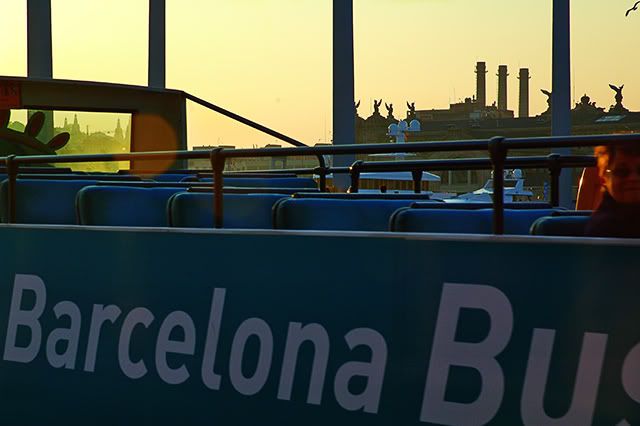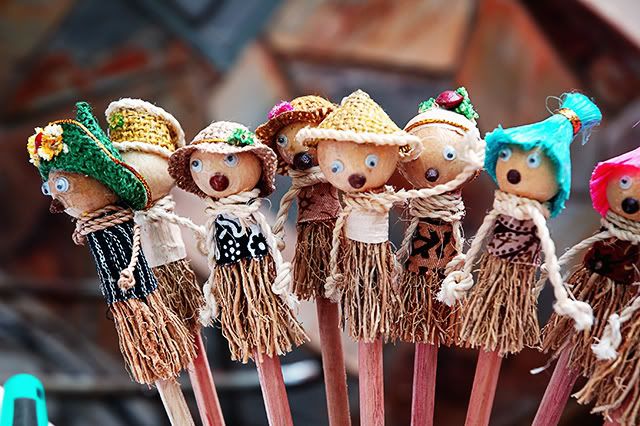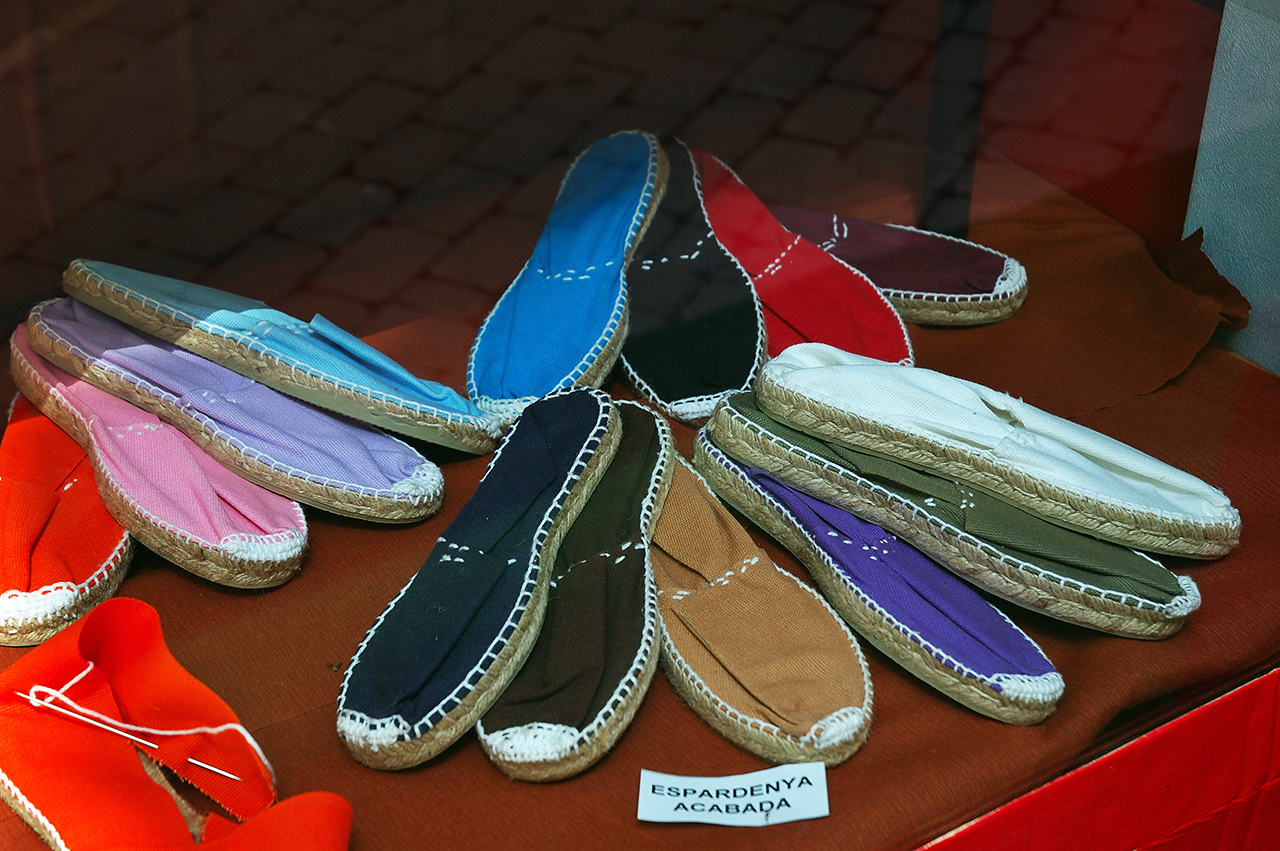This is the entrance to one of El Corte Inglés buildings at Av. Portal del Angel, 19-21. The most famous chain of department stores in Spain bought Galerias Preciados in the 90s, one of its main competitors and previous owner of the store. But before all that the place was known as Jorba department store or Can Jorba. The Jorba family, originally from Manresa, built it in 1932. Adorned with doric columns and a remarkable markee, this classicist building was conceived in the most pure XIX century style.
Barcelona photos: Daily photographs of Barcelona, Spain. Pictures of a modern city with travel tips in a personal photoblog. A photography and travel site. Art, architecture, people and traditions. Travel to Barcelona through my camera, know more about our city and towns nearby. Welcome!
Wanna be featured?
July 27, 2008
Marquee at El Corte Ingles, Portal del Angel, Barcelona
This is the entrance to one of El Corte Inglés buildings at Av. Portal del Angel, 19-21. The most famous chain of department stores in Spain bought Galerias Preciados in the 90s, one of its main competitors and previous owner of the store. But before all that the place was known as Jorba department store or Can Jorba. The Jorba family, originally from Manresa, built it in 1932. Adorned with doric columns and a remarkable markee, this classicist building was conceived in the most pure XIX century style.
July 26, 2008
July 25, 2008
Trixi Taxi Service in Barcelona
Moving around in the city of Barcelona is not as difficult as in other cities since metro and bus service is rather efficient. But when it comes to walking along the narrow streets of the old part of town you really need other means of transportation. Tourist itineraries are sometimes too demanding and impossible to cover in one day so a little push taking the short way can be extremely helpful to save time and get to places in a much better mood. So, how do you achieve that? By taking one of the so called trixi cabs I show today. The staff is generally well prepared, they know the language and are in good shape. These two trixies I spotted at Avinguda de la Catedral in Barri Gotic. To know about routes and price visit Trixi Taxis
July 24, 2008
Banco Vitalicio Insurance Company: Balcony and Lamps, Paseo De Gracia, Barcelona
In 1897 two companies called La Previsión and Banco Vitalicio de Cataluña merged into Banco Vitalicio de España, the insurance company we know nowadays. The first president was Claudio López Brú, in other words, famous Marques of Comillas who led Banco Vitalicio to top ranking positions in the market of life insurance companies. Besides life insurance they also dealt with cargo and transportation insurance. After the war, in 1943 the company also started to emerge in other sectors such as fire insurance, car insurance, etc. The headquarters at Paseo de Gracia where these beatiful lamps can be seen, was built in 1950 over the old Palacio de Samá premises. After 1991, Banco Vitalicio was completely absorbed by Central Hispano-Generali Insurance Holding who owned most of the stocks. At present it is presided over by José María Amusátegui de la Cierva. In 1997, a new modern and intelligent building was founded in Gran Vía de les Corts Catalanes. After more than a 100 years Banco Vitalicio is still one of the leading insurance companies in Spain. This is a picture I took back in 2006 of the whole building: Banco Vitalicio de España.
July 23, 2008
Sitar Player, Barri Gotic, Barcelona
To grow my collection of musical instruments here is a picture of a sitar. The musician was playing in Barri Gotic, a quarter that gathers a good amount of street artists who are attracted by the many tourists and special accoustics of its narrow alleys. Here is a famous video in which George Harrison is taking sitar lessons with Ravi Shankar
July 22, 2008
Old Lady and Fountain, Portal de L'Angel, Barcelona
The summer is very intense and humid in Barcelona. There were water restriction warnings last spring but after heavy and continuous rains, announced fines and water supply interruptions in public places were canceled. Here is an old lady filling up a bottle in one of those beautiful Barcelona fountains at Portal de L'Angel street.
July 21, 2008
Dali and Gaudi Souvenirs, Stall at Portal de L'Angel, Barcelona
July 20, 2008
Banco Vitalicio at Passeig de Gracia 11, Barcelona
This is a detail of Banco Vitalicio at Passeig de Gracia 11 and built from 1941 to January 1950 by Lluís Bonet i Garí. See more details about this bank and insurance company in my previous post: Banco Vitalicio: First High Rise Building in Barcelona. I am always attracted by the beautiful lamps on the façade. I don't know who's in charge of polishing them but they keep them like brand new.
July 19, 2008
Flashy Colors at Stall in Passeig de L'Angel, Barcelona
July 18, 2008
Spanish Menu for Rambla Catalunya Tourists
Walking down Rambla Catalunya street there are several terraces that are perfect to have some beers while you contemplate the wonderful architecture of art nouveau buildings and why not of some sculptural bodies especially in this time of year. But let's leave the female topic aside cause I digress. Well, you sit there and ask the waiter for a drink and perhaps a Spanish tapa. Man, I don't know if your budget can afford that but we absolutely try to avoid such places. I reckon they are comfortable and with a view but I can assure you that there are a handful of excellent places some blocks away for half the money and much better food. But go ahead, when you are a tourist you have to play the part; they tell you, and in spite of that, you go and squander your money. What the heck!, you say, these are my holidays. I understand I've done the same in Paris or in London. My advice, you try it but just once. Then mix up with locals they know better. Check that board again: tapas (which ones? there are hundreds!) and then Spanish omelette as the bait (isn't that a tapa). Tinto de Verano (literally, summer red wine), a mixture of cheap wine with Casera, a brand similar to Sprite. The drink is lighter than Sangria and more refreshing. Here is a Tinto de Verano recipe. Gambas are shrimps, hmm that's good but certainly you have them cheaper and tastier some other place. And beer, well, that you know. You have several words to ask for a beer according to the kind of glass or cup. You can order a caña (the smallest), a copa (a cup), a tubo (high and cylindrical glass) or a jarra (a jar). Then you have the bottle measure: the small bottle called quinto and the normal size "medianas" (tercios in other regions of Spain). I hope this odd mixture of Spanish food, tourism and bad reviews is at least helpful.
July 17, 2008
Tibidabo Roller Coaster Thrill, Barcelona, Spain

Not that it is a big roller coaster but watching the whole city of Barcelona while being up there, taking a scary look at the valley at your feet and raising your hands to enhance the thrilling experience is definitely a different way of approaching our city.
Take some time to visit Tibidabo. If you have kids it is really a must-see. Barcelona Photoblog has published many pictures about this park but I will only suggest a very similar shot: Amusement Parks - Roller Coaster Panic.
Labels:
amusement park,
attractions,
roller coaster,
tibidabo
Location: Barcelona, Spain
Tibidabo, 08035 Barcelona, Spain
July 16, 2008
Tibidabo Amusement Park Barcelona: Log Splash Attraction
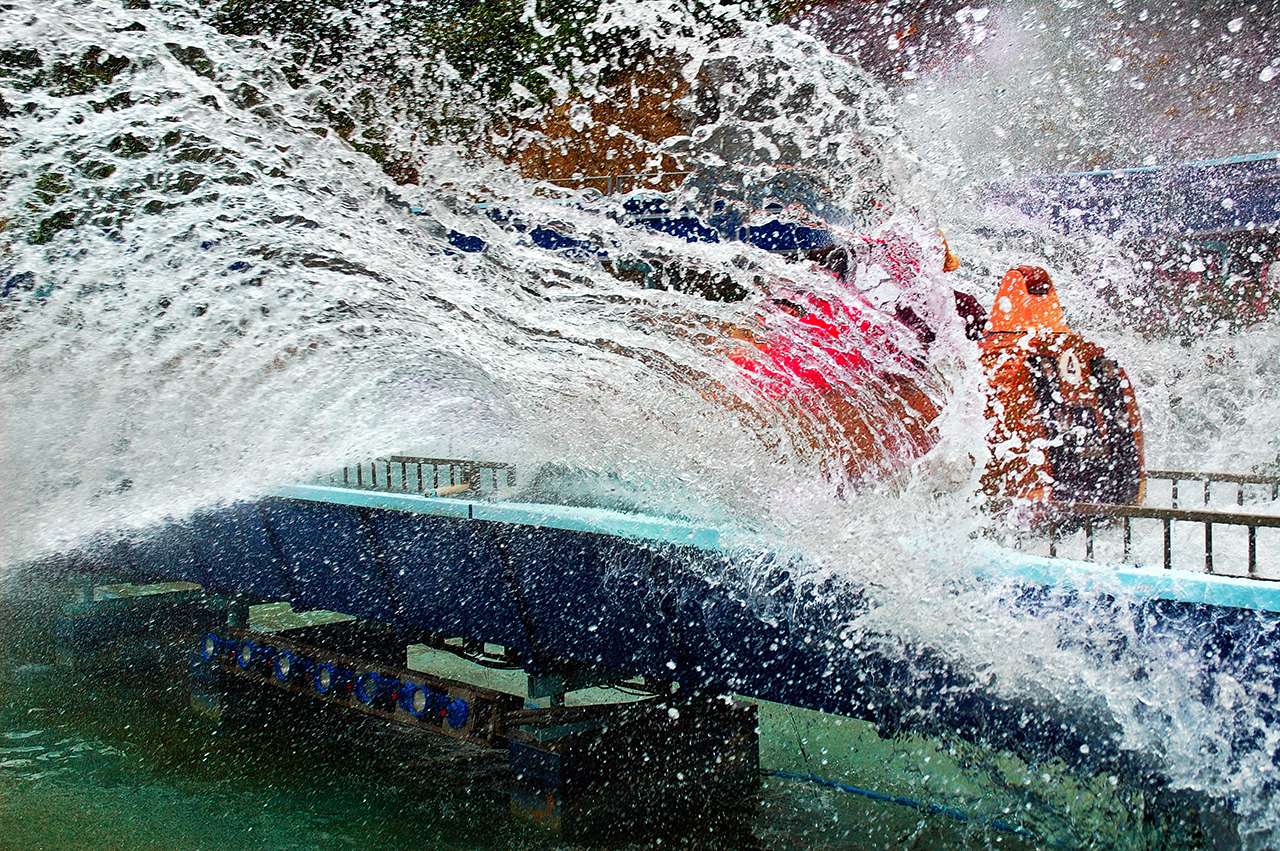 |
| Log Splash attraction at Tibidabo Amusement Park |
Although the picture today is about the log splash attraction in Tibidabo amusement park, you don't really get to see the log much here nor you see the slide. In fact I didn't want the log to appear since it is not specially attractive. This time I wanted to concentrate on the big waves spreading like imaginary wings over the water.
Labels:
amusement park,
tibidabo
Location: Barcelona, Spain
Tibidabo, 08035 Barcelona, Spain
July 15, 2008
Canon's House, Barri Gotic, Barcelona
At Bisbe Irurita Street in Barri Gotic there's this beautiful house called Casa de los Canónigos (Canon's House). Today I show you a detail of a sort of bas-relief you can admire on its façade while walking down the street towards Sant Jaume square. Read all the details about Casa dels Canonges.
July 14, 2008
Barcelona World Trade Center View From The Sea
Here is a very deceptive image in the sense that Barcelona World Trade Center looks like a small scale model next to an enormous cruiser moored to the pier. Maybe the other ship on the left helps the viewer find out what is huge and what is normal size here. Perhaps if you are an enthusiast of Barcelona Photoblog you remember that picture where I showed the other side of the pier: WTC: A Close Look. To have an idea of how it would all look from above watch it from the Mirador on Montjuic mountain.
July 13, 2008
The Nova Duana or New Customs House in Barcelona Harbor, Spain
 |
| Customs house in Barcelona harbor |
Here is another photo of the Barcelona Customs House building (in Spanish, Aduana). There were other posts featuring this beautiful façade: Barcelona Harbor_Las Golondrinas Sightseeing Boat and Barcelona Harbour Cruise: A City Teaser.
The Nova Duana (New Customs house), was built by Enric Sagnier (Barcelona, 1858-1931) together with Pere Garcia i Faria. Sagnier was a prolific architect. Other works of his were the Palace of Justice and the Tibidabo Temple. In all, he built about 30 interesting buildings only in Barcelona.
To finish I would like to mention the house El Pinar also known as Casa Arnús, a family house in the middle of a pine woods in Collserola mountain. You can see the lights of this house from Avinguda Tibidabo three times a week (Wednesdays, Saturdays and Sundays) so I recommend you try to spot it if you are in the area.
July 12, 2008
Barcelona Drummer: African Beat
We are going to park the bikes for a while cause this is not a motor site. Not that today's picture shows precisely anything about Barcelona but you know I am prone to changing topics easily. In fact, to make it a drastic change, I shifted color for BW. Portraits are not my speciality but I like the way the face insinuates the hands' drumming. For the other part of this photo check my previous link: African Drummer in Barcelona.
July 11, 2008
Barcelona Harley Days 2008: Lucky Devil Indian Bobber
This is a detail of a 1638 c.c./100 c.i. Indian Bobber (Lucky Devil) valued in 34.000 Eur. Barcelona Harley Days 2008 was a total success and according to official sources it gathered almost 10.000 Harley riders in Barcelona. I don't have photos of the flag parade but I captured some beautiful custom harley motorcycles that I will keep posting on coming days. Don't forget to click on the image for a larger version.
July 10, 2008
Harley Choppers in Barcelona Harley Days 2008 Event
July 09, 2008
Easy Riding in Barcelona Harley Days 2008
Harley-Davidson gathered thousands of motorcycles in Barcelona during Barcelona Harley Days, the official European festival celebrating Harley-Davidson’s 105th anniversary (2008).
I will be posting some pictures of this important event and I would like to start with just a backseat, a simple image to begin with as an appetizer. You might want to take a look at Harley-Davidson motorcycles from 1970 to present day or you may feel like reminiscing for a while:
![Click Video [enlarge]](https://blogger.googleusercontent.com/img/b/R29vZ2xl/AVvXsEiNi52uwSfqEqecariD2z4CCNH2GKtfV7yd3FaRt_LL78FeLN09jvdc3_kv4tHUmQY51a34-r8lZMusjDVwUUaP4LF7jjfvA0mPWsVr6lnPD4MNQmxyG6Sgsz-IFmkIWsmA_IErqA/s200/Easy+Rider.jpg)
July 08, 2008
Tourists in Park Guell Gardens
 |
| Japanese tourists at Park Guell gardens |
This is what we call a clotted picture. You might as well try looking for Wally, or in this case, a couple of Japanese tourists in the middle of the exuberant vegetation of Park Guell gardens.
You don't see what they are pointing their compact cameras at but I can tell you: it's the house where Antoni Gaudi used to live when he was building Park Guell which is a museum nowadays.
Labels:
park guell,
park güell,
tourists
Location: Barcelona, Spain
Park Güell, 08024 Barcelona, Spain
July 07, 2008
Japanese Tourists in Canaletas: Wrong Directions?
Last winter these Japanese tourists seemed to be lost and were desperately checking a map. I hope they were not looking for Canaletas fountain, the illustrious symbol of Barcelona Football Club, the place where we go to celebrate special victories (hmm definitely not this year), only because they got it right behind. Pushing the bad joke way too far I would dare to say some Real Madrid fan gave them the wrong directions on purpose. No, no, forget about this cheesy gag and concentrate on the place, Las Ramblas de Barcelona, the beautiful promenade and its people always coming and going, people from all over the world, having the hell of a great time in the city, both repetitive visitors and newcomers alike.
July 06, 2008
Wisdom: Catalonia Square, Barcelona, Spain
This is one of the statues at Plaça Catalunya (Catalonia Square). Around the center of the square there are different sculptures, each of them with an allegoric name. The one you can see in today's picture is called Sabiduría (Wisdom) and on the pedestal you can easily read the name of the artist: Miguel Oslé 1929.
July 05, 2008
Detail of Casa Lleó Morera at Passeig de Gracia 35, Barcelona, Spain

This is a detail of the small turret on top of Casa Lleó i Morera at Passeig de Gràcia 35.
The modernist house by Lluís Domènech i Montaner is part of the renown Illa de la Discordia (Block of Discord) called this way due to the clash of different styles between three famous houses in the block. The other two are Casa Amatller at Passeig de Gràcia 41 designed by Josep Puig i Cadafalch and Casa Batlló at Passeig de Gràcia 43 designed by Antoni Gaudí.
The building is located on the corner of Consell de Cent and Passeig de Gracia and was originally constructed in 1864 and renovated in 1902.
When you come to Barcelona it would be almost a crime not to visit this Manzana de la Discordia. For those that are less interested in art and more in going shopping, there's a Loewe shop in the ground floor.
July 04, 2008
La Unión y el Fénix Building, Passeig de Gracia 21, Barcelona, Spain

At Pg. Gràcia, 21 - Diputació, 265 - 267 we find this catalogued building of monumentalist style and French influence. It was built between 1927 and 1931 by architect Eusebi Bona i Puig and sculptors Saint Marceau i Frederic Marés. It is known as the Unión y el Fénix Español building, a Spanish insurance company that appeared in 1879 in Madrid after the fusion of other companies.
The company had venues all over Spain and although the buildings have been used for other purposes over the years, the original architecture has been preserved. The firm, due to an enormous debt had to merge with AGF Insurance (Assurances Gènérales France) in 1994 to form AGF Unión-Fénix which was later absorbed by German Allianz in 1999. It was Allianz who then created Fénix Directo the car insurance company that operates by phone.
La Unión y el Fénix on Passeig de Gracia is both a residential and office building. There are many other examples of monumentalist architecture in the city but this one was rather anachronic in the period it was built since almost all of them appeared after the civil war. It is another example of the efforts of the bourgeoisie to monumentalize Passeig de Gràcia street.
The fact that it is on a corner allowed for a rounded body building topped with a cupola crowned by the old company's symbol, a boy sitting on Phoenix, a mythical bird that dies in flames and is reborn from the ashes. Although according to experts, what the sculpture really represents is the Abduction of Ganymede by Zeus to serve as cupbearer to the gods. Ganymede was a symbol for the ideally beautiful youth in poetry.
July 03, 2008
Best Pastry Shops in Barcelona: Mauri
Mauri pastry shop on the corner of Rambla Catalunya and Provença is one of the best pastelerias (pastry shops) in Barcelona. Founded by Francesc Mauri in 1929 who owned Núria Restaurant one of the most emblematic at the beginnings of last century, Mauri was in the core of the most elegant and exclusive area of L'Eixample quarter. In 1955 it had to be restored after the damage caused by a fire. Although the founders had died some years before, the family kept the business going adding other services apart from traditional pastry and confectionery. A chocolate shop with tea room was inaugurated in 1978. In 1985 they opened up a delicatessen with catering and a restaurant. Although the price matches the uniqueness of the place Barcelona Photoblog highly recommends it not only for the offer but also for the epoch's modernist architecture which is well preserved.
July 02, 2008
Casa Mila: A Whole Lotta Door

Caught in the spiderweb of art, I fell I had to show you the door from within.
Check the outside here.
A whole lot of ironwork for a door, a huge smashing blow to all former architectural styles, the opening gates to the land of impossible things.
Ladies and gentlemen, welcome to La Pedrera and the imagination of Antoni Gaudi.
July 01, 2008
Poverty-Stricken Barcelona: Woman Begging, Paseo de Gracia
I won't judge this time. I leave it up to you. This is a woman begging on the corner of Passeig de Gracia and Plaça Catalunya, just in front of El Corte Inglés. One of the richest spots in Barcelona. It was a very hot afternoon, the normal kind of day this time of year, the same all stuff, lots of people, sweating all over. And there she was. People seemed to draw a safety perimeter around her with their feet. The same old story.
June 30, 2008
Ironwork on Balcony at La Pedrera or Casa Mila in Paseo de Gracia, Barcelona, Spain
I am sure this building Casa Mila also known as La Pedrera rings a bell. Maybe you saw the picture somewhere, in a postcard or in some expensive art book. Perhaps you are lucky enough to have visited Barcelona in the past and you wouldn't say no to a second or a third chance to see it. Well, it is never like the real thing, absolutely not, but if you click on today's image of the ironwork on one of the front balconies you will enjoy a very, very close shot of the famous façade. Not that there are few images like mine, but certainly you will appreciate every detail of the floral motifs. For more information read Casa Mila and follow the rest of links in the post.
June 29, 2008
Art Nouveau Lamp at Casa Mila or La Pedrera
This impressive art nouveau lamp that reminds me of some ancient diver's helmet or the head of a dragonfly with a little more imagination, hangs from the ceiling in the hall of La Pedrera or Casa Mila, built by Gaudi between 1906 and 1910. Brothers Badia were the iron forgers so I assume they had to do with this lamp but so far I haven't been able to find out who designed such beauty. You can find a thumbnail of La Pedrera on my Google Map below.
June 28, 2008
African Drummer in Barcelona
Percussion from the very source, the origins, Africa. Distant drums pounding communicating each other in the vast savanna. This is a detail of an African drummer, in fact they were too. They played at my daughter's school as part of the celebrations to say goodbye to 6th grade students graduating this year. Next year secondary school. Good luck Sara.
June 27, 2008
Guardia Civil Patrolling Barcelona Harbor
Some people have to do the dirty job so we all can enjoy the city in peace so a big thank to the boys. Not that they are very popular in Barcelona, but I guess the police has always and will always be criticized or laughed at cause we always see the wrongs and never give too much credit to their glorious acts or their silent work. Whether it's a madero, a flic, a cop or a bobby let them be.
June 26, 2008
June 25, 2008
Candied Fruit Pastry or Coca de Sant Joan
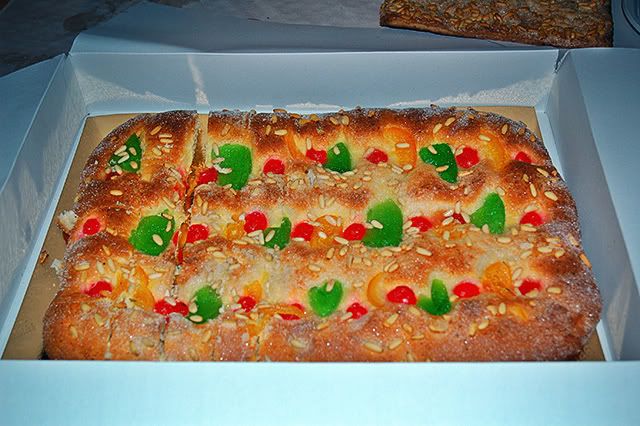
This is what is known as coca de Sant Joan, a traditional light sweetbread covered with candied fruit. As the name suggests, it is a kind of pastry to be consumed during Saint John celebrations when it is sold in huge amounts and as you can guess there are the cheap and the expensive ones. They can be tasty and spongy or an authentic hard rock. The cheapest you buy at the supermarket but if you want the best stuff then you'd better go to your favorite pastry shop. Besides the candied fruit "coca", there are other kinds, like coca de crema (cream filled pastry - this is the one I like the most), coca de llardons (suet pastry)...to have a better idea learn about cocas de San Juan. Maybe you prefer the recipe: Candied Fruit and Pinenuts Cocas.
June 24, 2008
Sant Joan Firecrackers: Launching Gadget Closeup
The word petardo in Spanish or petard in Catalan has different meanings: banger, firecracker, that is, a small explosive device. Not only that, it can be someone or something that's boring. Sometimes it can be a fraud but the most curious entries are "a hag, an old hag" what we know as a petarda and a joint, you know, the smoking kind. My intention today was to show not only firecrackers but the gadgets some people use to launch the artifacts. Many are completely handmade and others can be bought in stores. By the way, firecrackers are sold at special stalls which are regulated by city authorities. Normally they are located in the middle of a square with some fences all around and only two clients can be in front of the counter at the same time. Apart from that, you can also find specialized shops and major dealers for professional purposes.
June 23, 2008
Sant Joan's Eve Firecrackers
Bonfires of Saint John (Fogueres de Sant Joan in Catalan) aka Nit de Sant Joan or Revetlle de Sant Joan on June 23rd is time for firecrackers (petardos), cocas (a sort of pastry) and cava which is in other words the Catalan version of champaign. If you follow the above link you will find out that this event intended to welcome the arrival of summer is not exclusively ours although we celebrate it perhaps more intensely than in other places. It must be said that bonfires are not as popular now as in the past when people used to take old furniture into the middle of the street to watch it burn and party all around. Now you have to go to the beach where the city council still allows bonfires and massive celebrations. The mess is so big that special brigades of garbage collectors have to be organized to clean up the sand from all sorts of bottles, shoes, and assorted crap. Most of us avoid these mega parties and gather with family and friends to eat and drink till late in the evening. All night long before and after supper we find some place in the garden or go to the nearest square to ignite firecrackers. In spite of all this you can hear firecrackers big and small, during the whole month of June. The one in the picture was a turning wheel not particularly dangerous. Some others are scaring just like the sort of big tube a friend of us tied up to a pole. The artifact got twisted upon burning and sent "shrapnel" against the big bucket where we had the beers on ice, piercing through it and leaving a big hole that emptied the whole thing in seconds.
June 22, 2008
Polinesian Ship Attraction in Port Aventura, Tarragona, Spain
And here's another attraction at Port Aventura amusement park in Tarragona. The ship is located in the Polinesia area. I am not very fond of this one. I get sick with the ups and downs. This time I stood in the shade and calmly composed my picture. Don't forget to click on the image for a better view!
June 21, 2008
Pear Tree Flowers
Just some pear tree flowers I happened to shoot at the beginning of spring, if there ever was spring this year. Summer is already here, hot weather and all. Not that we had too many sunny days in the past two months.
June 20, 2008
Bacon but not Francis
To continue in my quest for a surprising topic that kills monotony a little bit I'd like to add another picture about Spanish food. I know many of you prefer to get in touch with local stuff be it culture, architecture, traditions or food rather than contemplating my last abstraction or the picture I took of my reflection in the mirror, you know. I hope you don't get too disappointed because I don't show Barcelona streets lately. It's just that I prefer being eclectic. Besides, the ugliest of things like bacon in this case may be interesting if you try to work out the best way to make it look attractive. In other words, you can have fun with you camera with the most obvious things. There was a previous post I recommend you visit too: Bacon: A Still Life Portrait and perhaps you'd like to check a curious site called I Heart Bacon.
June 19, 2008
Sausage Spread or Sobrasada
Sobrasada (Sausage Spread) is in the group of sausages made with pork. It is prepared with minced meat and lard. The great amount of Spanish paprika or "pimentón" gives it the characteristic color and the peculiar flavor. Sobrasada is a Majorcan speciality. Although you can buy it all over Spain, the authentic, the one that really makes a difference, is from Majorca in the Balearic Islands.
June 18, 2008
Spanish Food: Aged Manchego Cheese
![Spanish Food: Aged Manchego Cheese [enlarge]](https://i63.photobucket.com/albums/h135/carloslorenzo/AgedManchegoCheese_.jpg)
Named after La Mancha which is the Spanish region of famous Don Quixote, these aged Manchego cheese are made of sheep milk. They say the aroma reminds of lanolin and roast lamb. It has a slightly briny, nutty flavor and at the age of 13 weeks it is considered cured (curado). Over that period it is referred to as aged (viejo). There are other well known kinds of Spanish cheese: Cabrales, Idiazabal, Zamorano, Tetilla, Liebana, Roncal...In Catalonia we have Mató de Montserrat which is a fresh cheese (formatge fresc). From the Balearic Islands, specifically from Menorca, we have Mahon cheese which is one of my favorites. A link today: The Encyclopedia of Cheese.
June 17, 2008
June 16, 2008
Pan de Payés or Pa de Pagès: Traditional Peasant's Bread in Catalonia
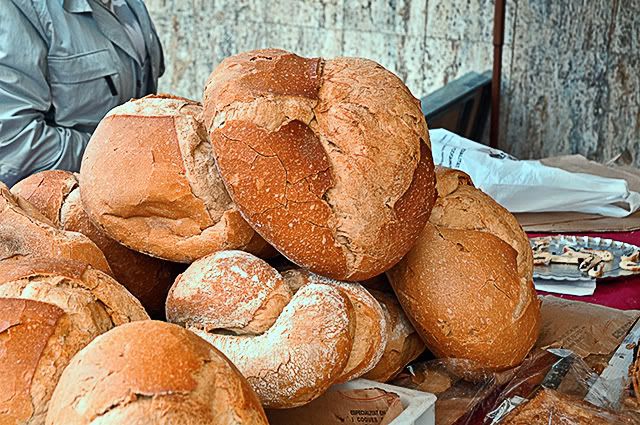
When you visit Barcelona or other cities and towns in Catalonia you will surely taste this bread known as pa de pagès, pan de payés or pan de pueblo (peasant or people's bread). Don't be scared you don't have to hold it and take a bite, just eat it in slices. At the baker's they'll cut it up for you. Maybe you have seen similar bread before since many Mediterranean products are already familiar to you in your country. What I am sure some of you are not aware of is what we do with the slices of pagès bread . But let's talk about this traditional Catalan product first.
El pa de pagès or pan de payés is a thick crusted bread with abundant crumb, higher carbohydrate content and less fat than a normal loaf. The thick crust is obtained thanks to a long kneading and fermentation time and a slow baking process. Due to its characteristics it is classified as a rustic kind of bread and as you already must have guessed by the name, people working in the fields were and still are the main consumers. As to the possible ways to serve the slices, there are lots of them. You can have them as such, although they are better in toasts, normally the ones popped into a barbecue grill taste better. Once you've got the toasts, you preferably spread tomato on top. How?
How to prepare pa amb tomàquet or toast with tomato
You cut the tomato into halves and rub it against the toast. Normally, you are given some garlic, olive oil and tomatoes together with the toasts so you wonder what about the garlic? Garlic is just an option although it is used on many occasions. If you have a knack for garlic then it is important that you cut one clove in two and rub it against the bread toast before spreading tomato, otherwise it is almost impossible to rub. Voila, you are almost there. Now you take the olive oil recipient, pour some on top of the slice of bread and finally add some salt. This part, which is the basis to prepare dozens of different kinds of pa de pagès toasts, is called pantumaca or pa amb tomàquet (bread with tomato pulp). The toast or the slice can then be dressed up with cured ham, anchovies, omelet, sausages, red peppers and aubergines in strips, all sorts of cheese...The ideal situation is to have high quality extra virgin olive oil from local olive oil producers although local does not always mean good. There are great olive oil regions like Cordoba or Lleida that are remarkably good at this. Try not to use any odd supermarket oil and see if you can buy those recently cropped real juicy and ripe tomatoes that are not hard to find in farmers' markets around many Catalan towns.
June 15, 2008
Wooden Donkey at Torrelles de Llobregat Market near Barcelona
June 14, 2008
Pickled Green Tomatoes in Barcelona
These pickled green tomatoes caught my attention at a street market. The bowl I found among other kinds of pickle products like olives or onions. It is not very common here to see green tomatoes prepared that way, at least not for us in Barcelona city. I was standing there preadjusting my camera settings and I had the opportunity to listen to some customers talking to the man in the stall. "Are these olives?" - they asked with surprise. "No, those are green tomatoes from Valencia" - said the stall man. It's a rather ridiculous story but I found the comparison between olives and green tomatoes rather ackward. Here is a green tomato pickle recipe.
June 13, 2008
Lantana Closeup in Barcelona
This is a lantana I came across in some Barcelona garden. It has been a very rainy season in the city in spite of the water crisis of past months so flowers look healthier than ever and make good photographs. Check an older picture of Lantanas. Have a nice weekend everyone!
June 12, 2008
Espadrilles: Spanish Alpargatas or Catalan Espardenyes
es·pa·drille (sp-drl) n. A shoe usually having a fabric upper part and a sole made of a flexible material, such as rope or rubber. The term espadrille is French and derives from espardenya, which derives from espart, the Catalan name for esparto [from Latin spartum] , a tough, wiry Mediterranean grass used in making rope. Espadrilles have been made in Catalonia since the 14th century at least. Here is a good place to buy yourself some comfortable espardenyes.
June 11, 2008
Street Market: Colorful Ribbons or Bracelets With Girl Names
Something I like about street markets in Barcelona and the rest of the country is that many times when you don't like what you see you can always go and refresh your eyes with the explosion of colors of South American stands. I mean, there is always a Bolivian or Peruvian stall where you don't know exactly what's on sale but you can't help staring with curiosity. Something is telling you that you want to buy. Not because of the pottery, the Che Guevara or Bob Marley T-shirts and the familiar leaf silhouette, not because of these personalized ribbons or bracelets with girl names but because of the whole impression, the warm colors, the Latin flashy hues that make the stand look more appealing than the rest. For me, much better than a 50 percent off sign.
June 10, 2008
Rusty Door Knocker in Torrelles de Llobregat , Barcelona, Spain
This beautiful rusty door knocker I captured at Torrelles de Llobregat near Barcelona although it could have been in Barcelona city perfectly as here we have many. The knocker represents some kind of mythological being perhaps. What do you make of it? I think I kind of like old door knockers and maybe I collect them in the future, the images of course. I remember a couple of posts in Barcelona Photoblog that you should check too: Vandalized Door Knocker or Modern Art? and Knocker on Chocolate Color Door at El Raval Quarter, Barcelona. Or maybe you prefer a list of famous door knockers.
June 09, 2008
Bobbin Lace or Encaje de Bolillos, Torrelles de Llobregat, Barcelona, Spain
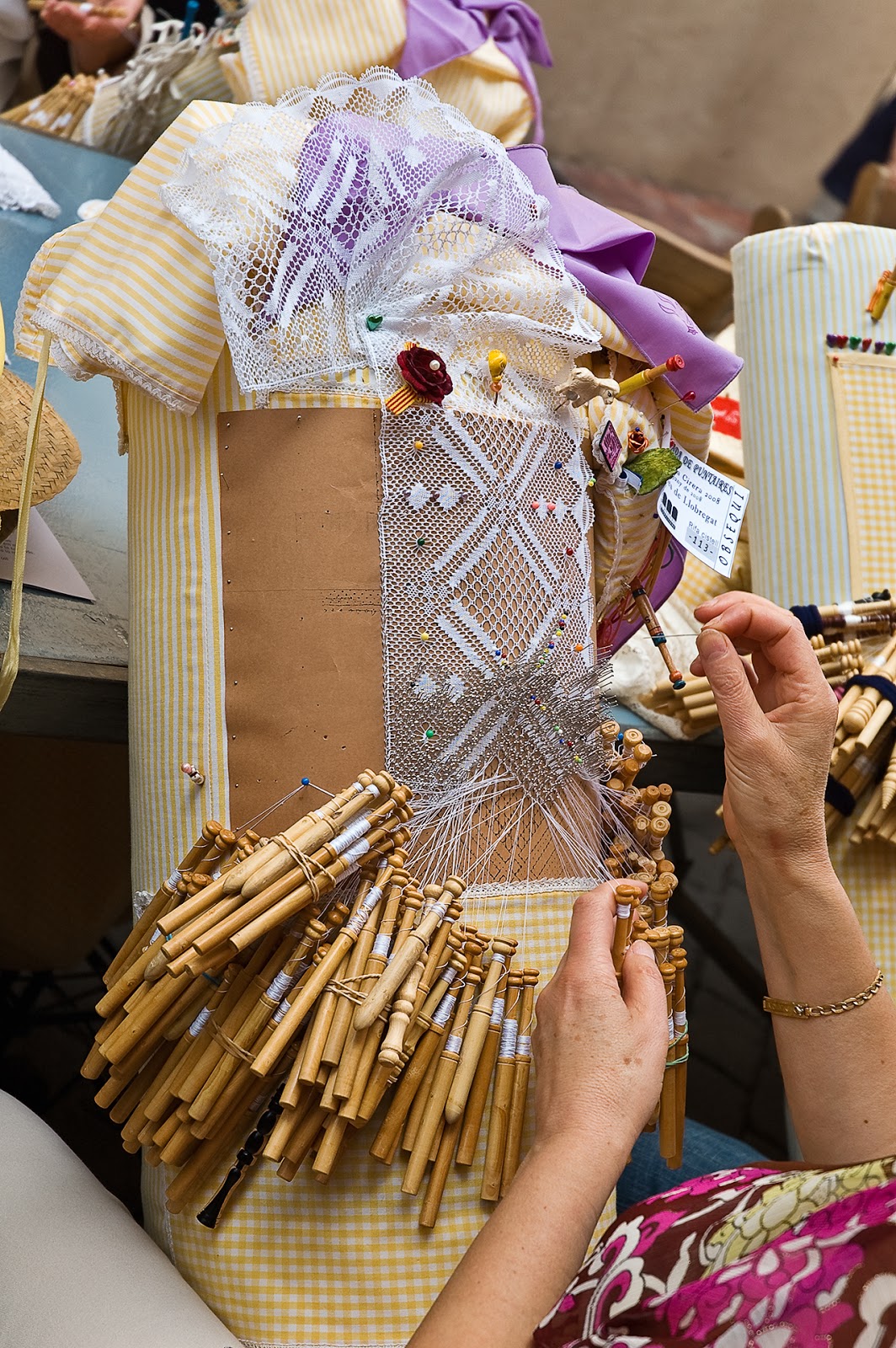
This is a picture I took in Torrelles de Llobregat. You can see here in detail how bobbin lace, known in Spanish as encaje de bolillos, is made.
First you need a pattern or parchment where holes are pricked to mark the place for all the pins. The parchment is always laid on a pillow or cushion. The lace is worked with each hand holding at least a pair of bobbins, the wooden elongated spools or shuttles hanging from the threads, which are moved from side to side to form a twist, a braid, or a clothlike fabric called toile. The motifs are worked in a more dense stitch, and the ground is made with a looser stitch.
Bobbin lace originated in Flanders in the early 16th century although some say it came from Italy. From Flanders it extended to the rest of Europe. It was used for ruffs and collars back then.
In Spain it was customary to teach girls how to work bobbin lace at school and at home as it was considered an essential part of a woman's education.
Check this video about bobbin lace. It is short and not too illustrative but it has a brief explanation in English that might help.
Labels:
bobbin lace,
lace,
traditions
Location: Barcelona, Spain
Torrelles de Llobregat, Barcelona, Spain
Subscribe to:
Posts (Atom)
Labels
architecture
(164)
modernisme
(81)
gaudi
(74)
art nouveau
(73)
food
(67)
flowers
(63)
street artist
(55)
sculpture
(48)
barri gotic
(39)
las ramblas
(39)
sagrada familia
(33)
dancers
(29)
beach
(28)
amusement park
(27)
port
(27)
human statue
(26)
art
(25)
mosaic
(25)
tibidabo
(25)
guell
(23)
barcelona streets
(22)
sant pau
(22)
tips
(22)
Catalan traditions
(21)
barcelona shop
(21)
market
(21)
montjuic
(21)
gothic quarter
(19)
la boqueria market
(18)
opinion
(18)
carnival
(17)
costa brava
(17)
domenech i montaner
(17)
christmas
(16)
ciutadella
(16)
maremagnum
(16)
folklore
(15)
classic
(14)
balcony
(13)
modernist
(13)
sea
(13)
street art
(13)
barcelona hotels
(12)
catalan art nouveau
(12)
catalan towns
(12)
costumes
(12)
graffiti
(12)
la pedrera
(12)
stained glass
(12)
casa mila
(11)
casa modernista
(11)
door
(11)
fountain
(11)
history
(11)
barcelona market
(10)
ceiling
(10)
la rambla
(10)
barcelona port
(9)
bikes
(9)
chocolate
(9)
crafts
(9)
paper mache
(9)
pedralbes
(9)
port aventura
(9)
vintage
(9)
architects
(8)
cosmocaixa
(8)
harbor
(8)
hotel
(8)
motorbike
(8)
passeig de gracia
(8)
arc de triomf
(7)
classic cars
(7)
dali
(7)
gracia
(4)
palau de la musica
(4)
accommodation
(3)
barcelona bar
(3)
casa batllo
(2)
cheese
(2)
cruises
(2)
gracia quarter
(2)
ham
(2)
wine
(2)
hostel
(1)
parc guell
(1)
picasso
(1)
